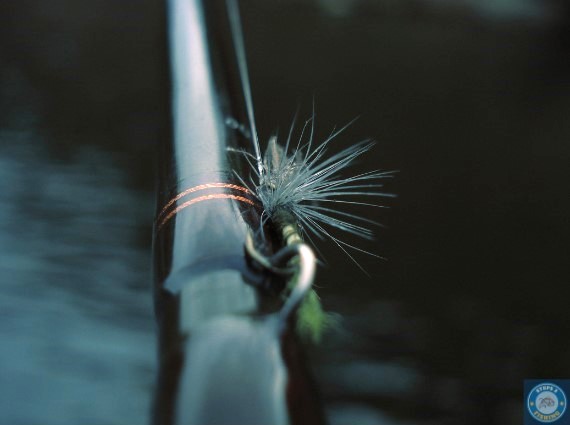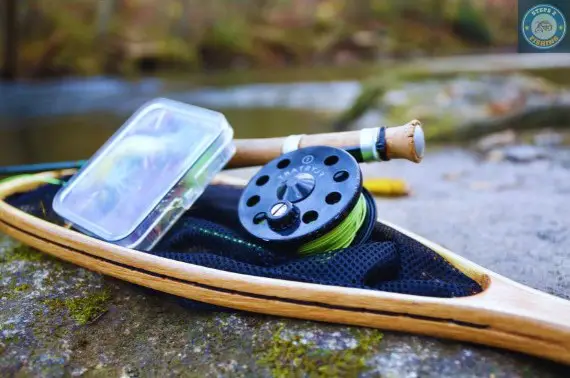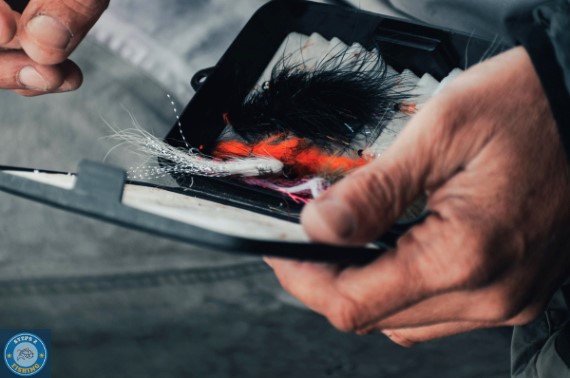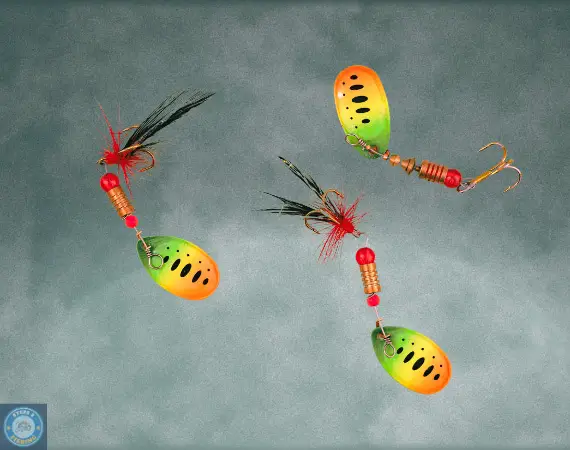
Trolling flies are a well-kept secret that seasoned anglers swear by in fishing. These unassuming lures can entice various fish species, making them an invaluable asset for any angler’s arsenal. In this guide, we delve deep into the world of trolling flies, uncovering the secrets of their effectiveness and providing invaluable insights to enhance your fishing experience.

What Are Trolling Flies?
Trolling flies are artificial bait used in fishing, specifically designed to mimic the appearance and movement of insects or smaller prey fish. They are typically made of feathers, fur, and other natural materials, expertly crafted to resemble the local aquatic fauna. These lifelike imitations are engineered to trigger the predatory instincts of game fish, leading to more successful catches.

Benefits of Using Trolling Flies
There are several benefits to using these gems. First and foremost, trolling flies offer versatility. They can mimic a variety of aquatic creatures, making them effective for attracting a wide range of fish. Secondly, they provide an interactive fishing experience. You control the depth, speed, and action, allowing you to adapt to changing conditions and fish behavior. Trolling flies often yield larger catches.
The Perfect Setup for Trolling Flies
Setting up your fly gear requires careful consideration. Start with a sturdy trolling rod matched to your fishing style and target species. Pair it with a reliable trolling reel featuring a smooth drag system, ensuring you can handle the toughest opponents. When it comes to line, choose one that suits your trolling depth and the size of your prey. Remember, a well-balanced setup is the key to success in trolling flies.
Trolling Rod Setup
Now, let’s talk about the nitty-gritty of trolling fly fishing. You’ll need a sturdy trolling rod. This is your trusty companion in the quest for the ultimate catch. It’s built to handle the challenges of trolling and allows you to control your line with finesse. So, when choosing your rod, look for one that matches your fishing style and target species.

Trolling Reel
Like a knight needs his sword, a troll fly angler needs the right reel. Your reel should be robust enough to handle the fight when a big fish bites. You don’t want it to give up the ghost in the heat of battle. Opt for a high-quality trolling reel with a smooth drag system.

Trolling flies for Trout.
Regarding trolling flies for Trout, anglers have a wide range of options. Trout are known to be discerning feeders, and the choice of trolling flies can significantly affect your success. Below, we’ll explore some of the best trolling flies for Trout:
Woolly Bugger
- Description: The Woolly Bugger is a versatile and highly effective fly for Trout. It imitates various aquatic insects, making it a go-to for many anglers.
- Color Variations: Olive, black, brown, and white are popular colors. Choose the color that matches the local forage.
Muddler Minnow
- Description: The Muddler Minnow is a classic streamer pattern known for its lifelike appearance. It can mimic small fish and sculpins, a common prey for Trout.
- Presentation: Fish it with a jerky retrieve to imitate wounded or fleeing prey.

Streamer Flies
- Description: Streamer flies come in various sizes and colors. They imitate baitfish, leeches, and other larger aquatic creatures.
- Action: Use erratic retrieves to make the streamer look darting and fleeing.
Marabou Leech
- Description: Marabou leech patterns are excellent for imitating leeches, a staple in a trout’s diet. They have a compelling undulating motion in the water.
- Colors: Black, brown, and olive are popular choices.
Zonker Flies
- Description: Zonker flies feature a strip of fur or synthetic material that mimics the movement of small fish. They are highly effective for enticing aggressive strikes from Trout.
- Variations: Choose from various colors and sizes to match the local baitfish.
Nymphs
- Description: Nymphs represent aquatic insect larvae and are a primary food source for Trout. They are usually fished deeper in the water column.
- Patterns: Pheasant Tail, Hare’s Ear, and Prince Nymphs are classic nymph patterns.
Dry Flies
- Description: While dry flies are typically associated with surface fishing, trolling them just below the surface can also be effective. They imitate adult insects that have fallen into the water.
- Patterns: Adams, Elk Hair Caddis, and Royal Wulff are popular dry fly patterns.
Baitfish Imitations
- Description: Choose trolling flies that closely resemble the local baitfish species. Realistic imitations can trigger aggressive strikes.
- Local Knowledge: Consult local anglers or guides for insights into the specific baitfish in the area.
- Size Matters: Consider the size of the Trout you’re targeting. Larger Trouts may prefer larger flies, while smaller ones prefer smaller patterns. Adjust your fly size accordingly.

Trolling Flies for Salmon
Before diving into the specifics of these flies, it’s essential to understand the fundamentals of Salmon.
Choosing the Right Trolling Flies for Salmon
Salmon are renowned for their discerning feeding habits, and their preferences can vary depending on several factors, including the season, water temperature, and the specific salmon species you’re targeting. Here are some top trolling fly patterns that have proven effective for salmon:
Flash Flies
- Description: Flash flies are designed to reflect light and create attention-catching flashes underwater. Their shimmering appearance can be irresistible to salmon.
- When to Use: These flies are particularly effective on sunny days when the sunlight can make them sparkle.
Streamer Flies
- Description: Streamer flies mimic the appearance of small fish, a favorite meal for salmon. They have a lifelike swimming motion in the water.
- When to Use: Streamers are versatile and can be used throughout the season. However, they are especially effective during the salmon’s migration.
Tube Flies
- Description: Tube flies are highly customizable and versatile. Anglers can experiment with different colors and sizes to match local baitfish and conditions.
- When to Use: Tube flies are a great choice when you want to adapt to changing conditions and imitate various prey species.
Nymph Flies
- Description: Nymph flies represent aquatic insect larvae, a crucial part of a salmon’s diet. They are typically fished deeper in the water column.
- When to Use: Nymphs are particularly effective in rivers and streams, especially during salmon runs.

Trolling Flies vs. Traditional Lures
One might wonder why trolling flies stand out among the many fishing lures available. The key lies in their versatility and effectiveness. Unlike traditional lures that often rely on flashy, noisy designs, trolling flies offer a subtler approach. They excel in clear-water conditions and when fish feed on smaller prey, making them a top choice for discerning anglers.

The Science Behind These Flies
Color Selection
Choosing the right color for your trolling fly can significantly impact your success on the water. Fish have a keen sense of colors, and what they like can change depending on how clear the water is and how much sunlight there is. Generally, fish tend to go for brighter colors like red, orange, and yellow in murky water, while in clear water, more natural colors like green and brown do the trick.
Size Matters
The size of your trolling fly is another critical consideration. Smaller flies tend to attract panfish and Trout, while larger ones are ideal for targeting bass and pike. It’s essential to match the size of your fly to the target species and the local forage base for the best results.
Action and Presentation
The lifelike action of trolling flies is what sets them apart. Mimicking the natural movements of insects or smaller fish is crucial for success. To achieve this, anglers employ various retrieval techniques, such as the slow figure-eight or the erratic jigging motion. Experimentation and observation are key to finding the perfect presentation that entices the fish in your area.

Best Techniques for These Lures
These lures are all about finesse and adaptability. The most common approach is to vary your speed and depth, mimicking the natural movement of prey. Slow down when fish are sluggish, speed up when they’re active, and adjust your trolling depth to match their location.
Downrigger Setup
A downrigger system is one of the most effective ways to present these flies. This method allows you to precisely control the depth at which your lure swims, ensuring it stays within the strike zone of your target species. Using a downrigger, you can adjust the trolling depth based on your observations and the preferences of the fish you’re pursuing.
Lead Core Trolling
Lead core trolling is another popular technique for anglers chasing deeper-dwelling fish. By attaching a length of lead-core line to your trolling setup, you can effectively control the depth at which your trolling fly operates. This method is particularly effective for reaching suspended fish at various depths.
Surface Trolling
As the name suggests, surface trolling involves keeping your trolling flies near the water’s surface. This is effective for species that feed on insects or smaller fish at the top.
Conclusion
Trolling flies are a versatile and highly effective tool in the angler’s toolbox. Their ability to mimic natural prey and trigger predatory instincts in fish makes them a top choice for those seeking to up their fishing game. You can significantly increase your chances of success on the water by mastering the art of trolling flies, selecting the right colors and sizes, and employing various rigging techniques.
With this comprehensive guide on trolling flies, you are well-equipped to enhance your fishing adventures and outperform the competition. So, cast your line with confidence and reel in those trophy catches!
FAQs
Q. Are trolling flies suitable for freshwater and saltwater fishing?
A. Trolling flies can be used in fresh and saltwater environments, making them highly versatile.
Q. What’s the best time of day for trolling fly fishing?
A. Early morning and late evening are often considered the best times, but it varies depending on the species and location.
Q. Do I need specialized rods for trolling flies?
A. While specialized trolling rods are available, you can often adapt existing fishing gear for trolling fly fishing.
Q. How do I maintain and clean my trolling flies?
A. Rinse your trolling flies with fresh water to remove salt and debris after each use. Dry them thoroughly to prevent rust and deterioration.
Q. What’s the most challenging aspect of trolling fly fishing for beginners?
A. Mastering the art of presenting trolling flies in a lifelike manner to entice fish can be the most challenging aspect for newcomers.


Leave a Reply